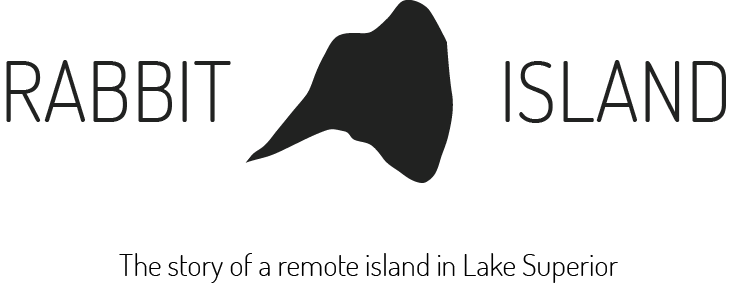
We are now accepting applications to the 2023 Rabbit Island Residency Program. This year we anticipate awarding three residencies that will take place between June and September. With the support of the National Endowment for the Arts and continued contributions from donors we are excited to offer successful applicants the following:
- $3,000 (USD) unrestricted honorarium
- 3 week residency on Rabbit Island
- Exhibition in the annual Rabbit Island publication and online archive
- Connections to partner institutions for exhibition and performance opportunities
- Mainland housing as needed
Further award details, requirements, and a comprehensive Application Guide, are available on the Artist Residency page at the link below.
The deadline for application is March 31, 2023, at 11:59pm EST.
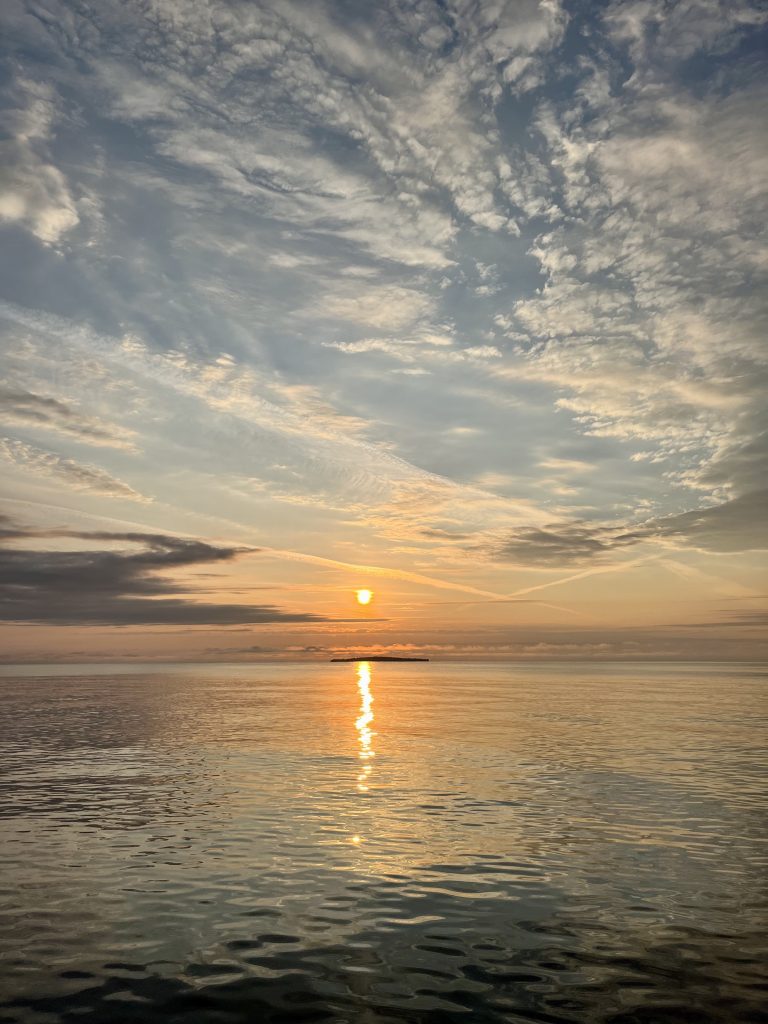
We look forward to welcoming a new group of resident artists to the island this coming summer for the 2023 Residency Program. Details for the open call will be released soon. Make sure to check the Artist Residency page to sign up for the mailing list.
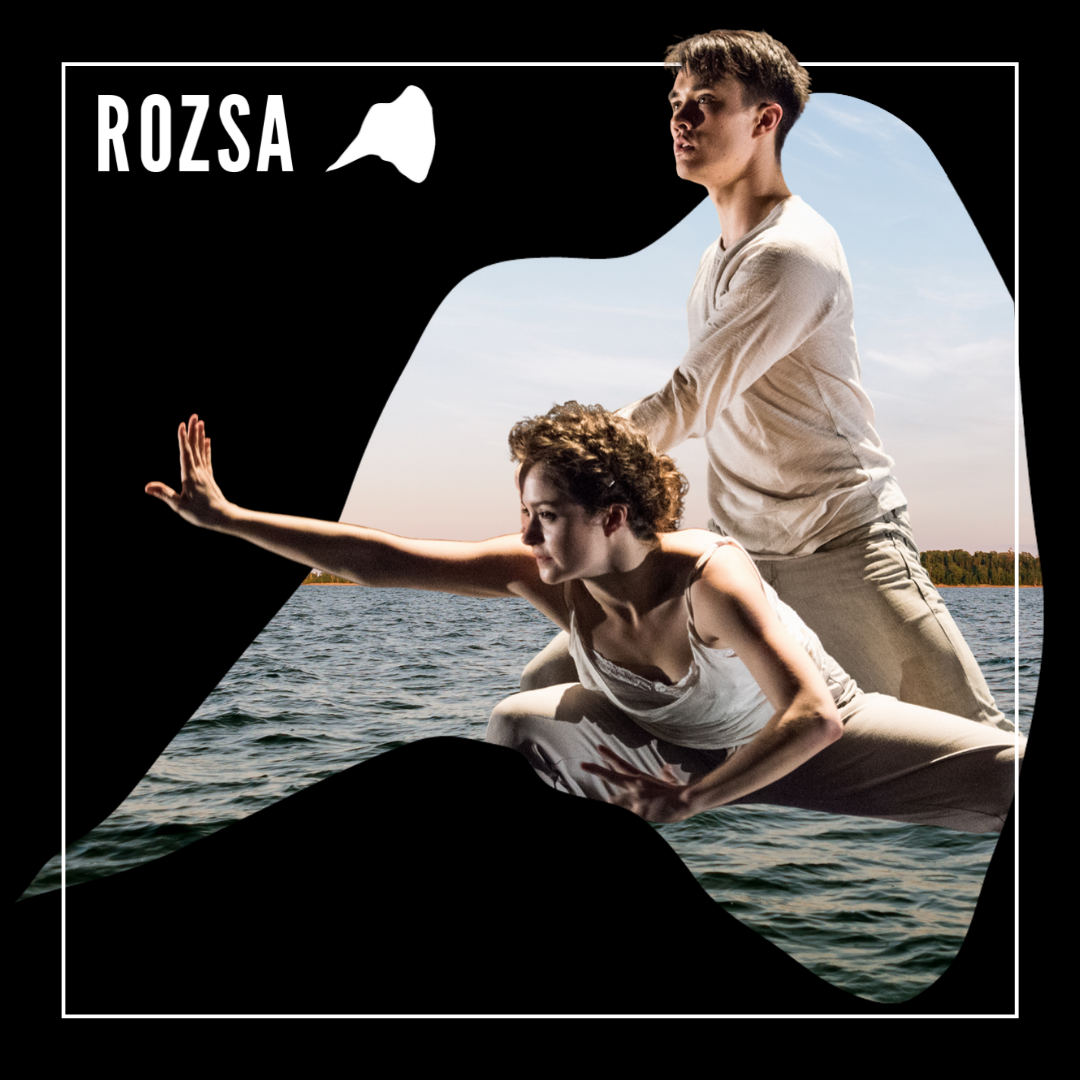
ANCHORAGE, a Rabbit Island world premiere.
Join us Saturday, November 13, 2021, at 7:30 pm Eastern for the premiere of a newly commissioned collaborative work by choreographer Yoshito Sakuraba and composer Na’ama Zisser. Event tickets and livestream information is available at https://events.mtu.edu/event/anchorage_world_premiere
Presented in collaboration with the Rozsa Center for the Performing Arts, this premiere marks the inaugural performance from our Choreography and Composer Residency program. Na’ama and Yoshito spent two weeks on the island in 2019 followed by a week on the mainland at the Rozsa Center.
The concept-responsive residency asks composers and choreographers to consider the current canon of dance and composition in the context of contemporary ecological thought. Its intent is to encourage bold creative experiments that meaningfully engage human relationships to the natural world, in a way that these mediums have not done so historically. As the understanding of ethics within the Anthropocene evolve, so too must our cultural works that are created within it.
Congratulations 2021 Residents
We are excited to announce awarded residencies for the Rabbit Island 2021 Residency program. Four residencies have been awarded featuring a total of six artists. Each will live and work on Rabbit Island this summer pursuing research and work that aims to interrogate and expand the dialogue between culture and conservation. Each residency is supported by an unrestricted honoraria of $3,200 USD made possible by grant support from the National Endowment for the Arts. The awarded residents are:
Laura Moriarty
Aly Ogasian & Claudia O’Steen
Avery Williamson
Lucía Hinojosa Gaxiola & Roosmarijn Pallandt
Along with the brief biographies and artist statements below, we are sharing the awarded proposals in full. We do so in the interest of transparency, archival intention, and to provide insight into the quality, critical nature, and ambition of the proposals we receive. However, the residency program acknowledges these proposals often transform in response to the residency. We look forward to sharing the residents’ works and experiences as they evolve, and are influenced by their time on the island and period of reflection after.
Since 2011 the Rabbit Island Residency program open calls have received over 2,100 applications. Since that time the program has supported 34 awarded residents and hosted over 80 collaborators. The experiences have resulted in artwork, writing, compositions, performances, and more that critically engage issues of conservation and natural spaces. As society continues to face these contemporary challenges we are excited to have Rabbit Island’s residents contribute to this ongoing dialogue.
The committee extends a sincere thank you to all the applicants. This year’s selection was the most difficult to date, given the unprecedented number of thoughtful proposals supported by exemplary work. While we regret not being able to offer more residency positions, it is an honor to be working with the following artists over the next year.
Read the complete details of the selection process
Rabbit Island 2021 Residency Selection Committee
Alice Pedroletti, 2018 resident
Duy Hoàng, 2018 resident
Luce Choules, 2016 resident
Patricia Buffa, Director of Digital Strategy for Fine Arts Museums of San Francisco
Rob Gorski, President of the Rabbit Island Foundation
Rabbit Island 2021 Residency Selection Coordinator
Andrew Ranville, Director of the Rabbit Island Foundation
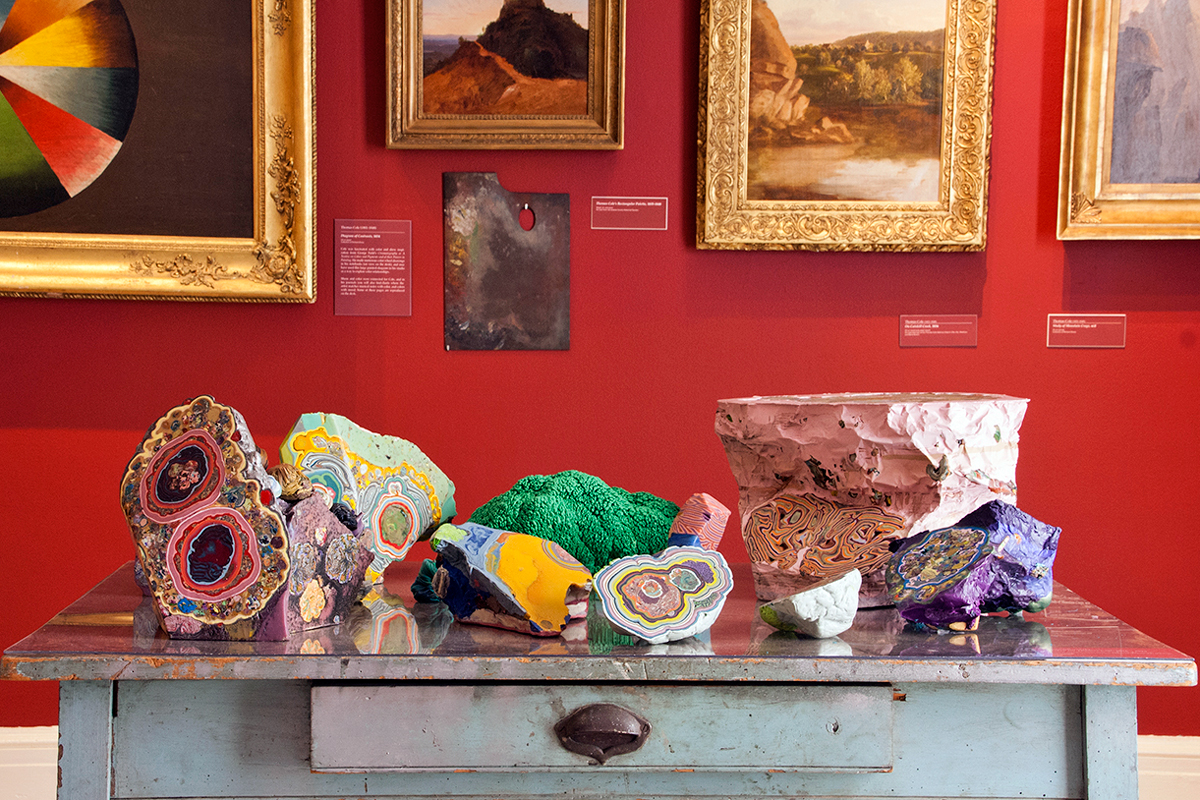
Laura Moriarty
Biography
Laura Moriarty is an artist from and currently located in New York’s Hudson River Valley. She makes process-driven works with pigmented beeswax whose forms, colors, textures and patterns result from processes similar to those that shape and reshape the earth. Her work has been presented in numerous solo and group exhibitions. In 2021, her solo exhibition, Resurfacing, was featured at the Hunterdon Art Museum in New Jersey.
Artist Statement
Taking poetic license with geology, I compare the processes of the studio with processes of the earth, creating sculptural paintings and related works on paper that recall natural formations. Layers of color form the strata of a methodology in which the immediacy of the hand can translate a sense of deep time. Working and reworking molten, richly pigmented beeswax, I build each piece through a slow, simple yet strenuous physical engagement, which often becomes a metaphor for the ephemerality of life and civilization. As if dug from the center of the earth, my pieces often resemble scientific models or artifacts whose strata and embedded fragments reveal a history, just as the layers of the earth itself tell a story of climate shifts, planetary events and cataclysmic disruptions. In my work, each layer resurfaces the one below, creating successive tiers that vary in thickness and color, marking new eras, delineating ages, and trapping stories that are part of the time/space continuum.
Proposal
My vision for the Rabbit Island Residency is to commune with nature in monastic solitude for three weeks. My daily practice will include exploring, collecting, and studying the rocks and minerals of the island, which will culminate in the creation of a series of nature dioramas.
Historically, the diorama is a model representing a scene with three-dimensional figures, either in miniature or as large-scale displays. In my Rabbit Island dioramas, rocks and stones will take the place of human figures - not as stand-ins, but as entities in their own right, turning notions of “life” and “matter” around. The Rabbit Island residency strikes me as an ideal environment for this project, which recalls my childhood experiences of a world populated by animate things, rather than passive objects. What is most important to me is to consider the essential vibrancy of matter, and in this sense it is a philosophical project. I want to think slowly and deeply about the idea that rocks are a vital force.
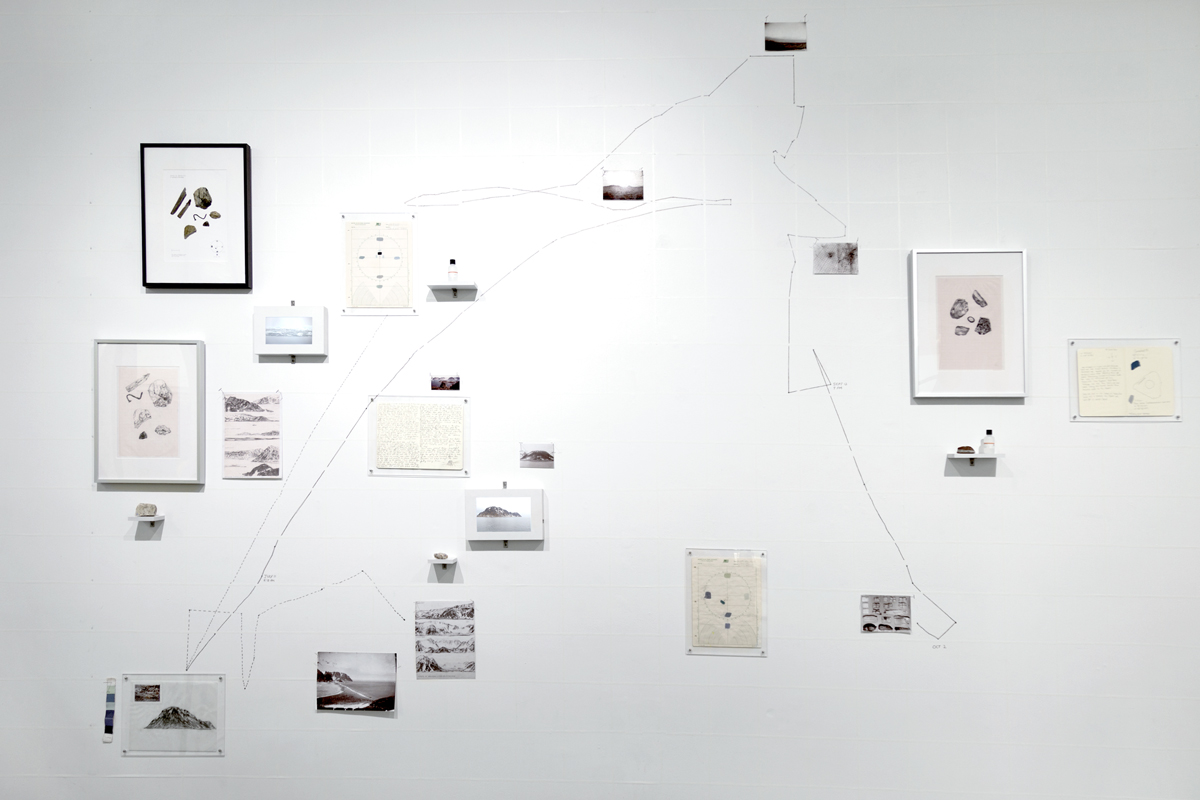
Aly Ogasian & Claudia O’Steen
Biography
Claudia O’Steen and Aly Ogasian are a collaborative artist duo based in Charlotte, North Carolina, and Los Angeles, California, respectively. They have previously been awarded collaborative residencies at Hambidge Center for the Arts & Sciences, Rural Projects, The Wassaic Project, Montalvo Arts Center, The Arctic Circle, and NCCA Saint-Petersburg, and have exhibited both nationally and internationally at venues such as The Russian State Arctic and Antarctic Museum, apexart, Flux Factory, Manifest Creative Research Gallery and Ohio State University amongst others. Claudia received a BFA from Watkins College of Art Design & Film and an MFA in Digital + Media at Rhode Island School of Design. She is Assistant Professor of Fine Arts at Winthrop University. Aly received a BFA from Queen’s University and a MFA in Digital + Media at Rhode Island School of Design. She is an Assistant Professor of Art and Design at Scripps College.
Artist Statement
O’Steen and Ogasian work collaboratively to produce multimedia, research based installations. Their work incorporates sculptural elements, digital media, drawing, writing, and photography, and their studio practice takes a flexible, idea driven approach.
Their projects always involve fieldwork, and installations incorporate artifacts and “data” collected from the landscape itself, and are inspired by their immediate surroundings. Their work focuses on our relationship with a changing environment, and uses methodologies borrowed from citizen science to critique traditional notions of exploration and conquest.
They attempt to re-orient themselves in a contemporary world dominated by data and technology, where the romantic and adventurous spirit of discovery has been lost or forgotten. They are interested in the moments where science and technology give rise to the nebulous, the enigmatic, the mysterious – where the primary goal is to “make sense” rather than to objectively know.
Technology is inherently part of the process of exploring, allowing the artists to extend their bodies, senses, and thoughts across great distances whether deep within or far away. Within this context, wonder connects to an instance of “new knowing”, a re-encountering of familiar terrain.
Their work is performative, casting the artists in the role of explorer or knowledge seeker within scenarios that are at once deeply absurd and poetic. The glitches or errors that occur within the process are celebrated not only as deviations from the intended path, but as potential points of departure for the imagination.
Proposal
Due to its size and depth, Lake Superior exists at a multitude of scales simultaneously, slow moving river, lake and ocean. Fluctuating water levels, monitored in real time across days, years and centuries contribute to our understanding of climate change and its impact on weather, ecosystems and coasts.
For Rabbit Island, we will develop a series of portable sculptures that will function as observational stations as well as repositories of information. These sculptures will be inspired by the NOAA monitoring systems used locally such as the Great Lakes Water Levels Monitoring Network.
Acknowledging that every detail matters, our systems will monitor minute changes that occur on the ground over the time span of the residency. We will poetically measure wind, waves, visibility, water-level and temperature, exploring both the possibilities and limitations afforded by perceptual observation. Our observations will be contextualized vis-a-vis large, ongoing collections of data via satellite imagery, scientific instrumentation, human memory and citizen science intended to help predict the future of the lake. The project will touch upon the lake as a “site of memory” by examining how winter conditions contribute to subsequent summers, while also engaging human memory by exploring indigenous observations of the landscape.
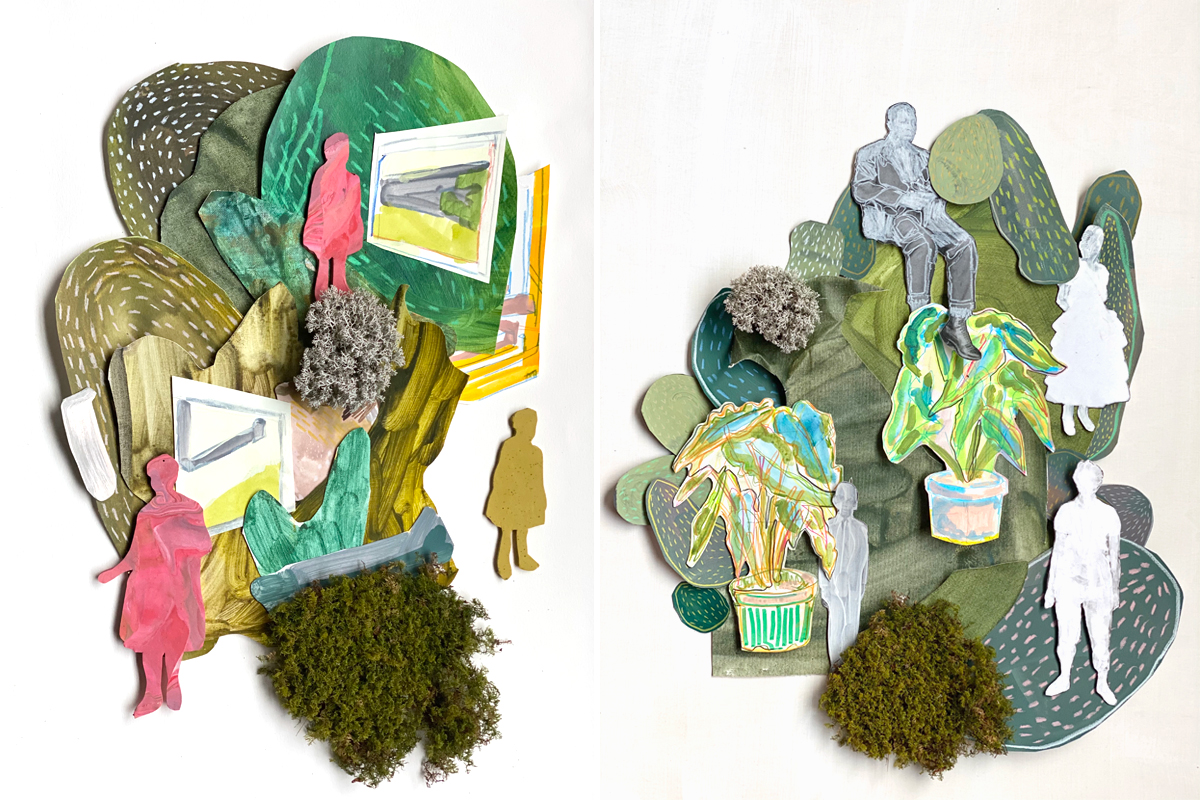
Avery Williamson
Biography
Avery Williamson is an artist and designer originally from Philadelphia, Pennsylvania, currently living and working in Ann Arbor, Michigan. She graduated from Harvard College with a degree in Visual and Environmental Studies. There she was awarded the Thomas Temple Hoopes Prize for extraordinary undergraduate work. Williamson has since shown work in New York, Philadelphia, Nashville and Ann Arbor. Her work has been featured by the Instagram Design Team, the American Craft Council, Oprah Magazine, Martha Stewart Magazine, The Strategist, Bustle and Etsy.
Artist Statement
I am a multidisciplinary artist whose work explores historical and contemporary notions of the archive, Black pleasure and spatiotemporal collapse. My body of work includes weaving, photography, jewelry, painting and drawing. Through these media I explore the narratives of Black women in personal and institutional archives. Within the archive, women are defined by names, occupations or skin color. I return to particular images and remake them in glitter, collage, cloth or color in order to free these figures from the historical narratives into which they’ve been embedded. Visible Black pleasure is important to my practice. Pleasure is safety, experimentation, and choice. Pleasure makes possible the imagination of alternative futures where Black life is expansive and unrestricted.
Proposal
I am interested in using the Rabbit Island Residency to create a collection of collages that include silhouette figures and native plants and materials. The silhouettes are of my grandparents, great aunts, and compelling strangers in my family album. The collages containing these silhouettes serve as the site of time-collapse where people can be at play, in company and in conversation. They are not wedded to any particular time, place or constraints. The organic material introduces the constant of nature through generations. While the homes and structures that housed the ancestors may not exist, the trees, grasses and moss that surrounded them remain. Collage is a material practice that allows me to process experiences for which I do not yet have words. Rabbit Island offers the opportunity for me to consider nature, and site-specific materials as part of or even the foundation of the collages. The plant life and other naturally occurring materials will provide texture to the collages.
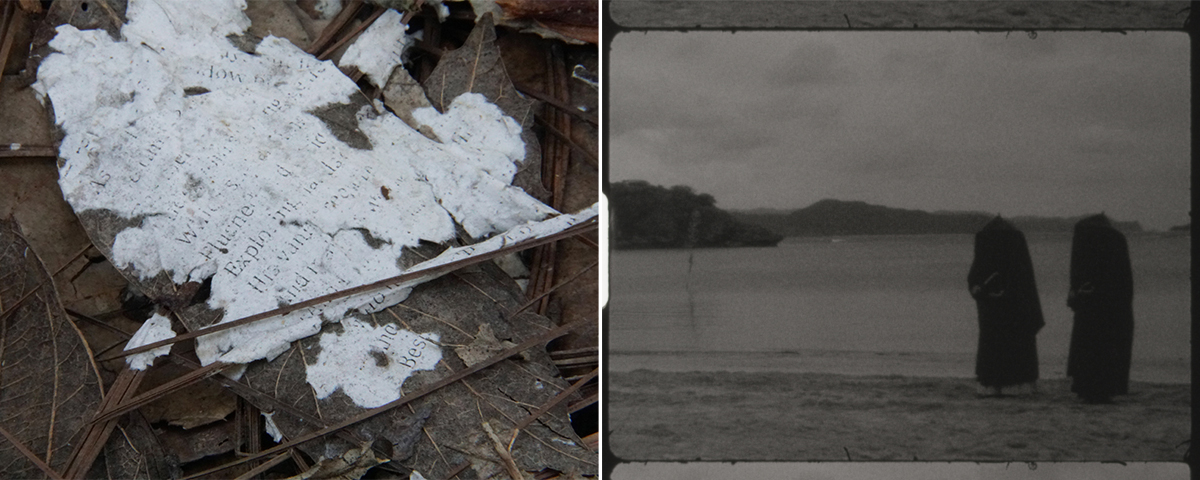
Lucía Hinojosa Gaxiola & Roosmarijn Pallandt
Biography
Lucía Hinojosa Gaxiola is an interdisciplinary artist and writer from Mexico City. Her time-based practice explores the fluidity of language through investigative poetics, resulting in a corpus of visual, sonic, and text-based works. She has exhibited and performed at galleries and venues like Centro de la Imagen (Mexico City), Sala de Arte Público Siqueiros (Mexico), Audiograft Festival of Sound Art (Oxford), Chalton Gallery (London), Grice Bench Gallery (Los Angeles), The Poetry Project (NYC), Anthology Film Archives (NYC), among others. Her critical writings & poems have appeared in The Brooklyn Rail, GasTV, Dolce Stil Criollo, Bombay Gin, philoSOPHIA, Precog Mag, and other publications. She received a BFA in Visual & Critical Studies from SVA, and completed the 2-year program at SOMA in Mexico City. In 2013, she co-founded the experimental editorial platform diSONARE and recently started RIZOMA, a series of performance workshops for imprisoned women.
Roosmarijn Pallandt is a cross-disciplinary visual artist from Amsterdam. Her works echo and embody themes of recollection, transformation, and universal knowledge. She uses a distinct artistically driven research methodology, immersing herself in biotopes as diverse as the deserts, jungles and mountains of Japan, Tibet, and Mexico, among other places. She often employs extensive dialogue with indigenous communities enabling creative collaboration to meet with these natural worlds. Currently her practice extends itself towards the constant metamorphosis and emergence of form, with a focus on the intelligence of nature, shamanism, and the invisible bonds that make up the fabric of life. Roosmarijn’s work has been shown at Museo de Arte de Zapopan, Mexico, Contemporary Gallery, Kunming, China; Lumen, London, UK; Desert Festival, Alice Springs, Australia; and Kyotographie Japan, amongst others. Her writings and performances have been featured in The New York Times, Phases, FRAME, Damn, Mr Motley, Vogue Japan, SeeAllThis, TL magazine, and more. Her work has been featured in recent publications by VOID photo; Book of Change by Stephen Ellcock, published by Princeton Architectural Press; and Tehran – Life Within Walls, edited by Hamed Khosravi, published by Hatje Cantz. She has been a visiting lecturer at The Sokei University Tokyo, OIST University Okinawa, Delft University of Technology, and the San Francisco Art Institute.
Artist Statement
Lucía: Within the fields of environment, memory and time, I explore the limits of language, using entropy as a rubric to explore broader definitions of forms. My practice is essentially a process; a method of investigative poetics that results in a corpus of visual, sonic, and text-based works. I think of my practice as a drift within residues that are never vanished, but evoking new mind collisions, revealing new or possibly hidden epistemologies.
Roosmarijn: In search of a deep sense of shared belonging and interdependence, my work explores connections among mythology, geography and the ambiguous intersections of memory and perception, I seek the depth of ecological interdependence and the subtle connections that make up the fabric of life. Fascinated by infinite versions of narration bursting out through the emergences of patterns and rhythms that make up the living world, I build installations employing photography, film, textiles and sound.My practice is an exploration into deeply rooted knowledge of ceaseless cycles and its memory and power to transform. My work allows the viewer to step into a multi- dimensional and continuous flow of pulsations, where nothing is ever static.
Proposal
Ecology is the house of logos, our dwelling place. But language is endemic. And orality—sound—a mimetic action. How can one engage with an environment’s dynamism, where language’s pulse is mysteriously hiding? How can a landscape reveal its own rhythms, patterns and frequencies to the human mind and spirit?
Through sound recollections and field recordings, walks, exercises for deep listening and poetic experimentations, we want to create an ecological partiture in collaboration with the Island’s rhythmic energy, to ultimately create a sound installation and interspecies performance, translating the resonance of living organisms into a multidimensional eco-score.
By aligning our biological tempos to the landscape using different recording techniques, we want to establish an intimate dialogue with the Island as both, a place and a being with a specific vibration.
Being two interdisciplinary artists from different backgrounds interested in the deep ecology of sound, we come together to explore the elemental flow of occult language and the interrelation between species. We want to honor Rabbit Island by engaging with the landscape’s hybridity as a body of water, air, fire and earth that is evolving with millions of species, providing counterbalance and ecological resistance to the earth’s catastrophic climate disaster.
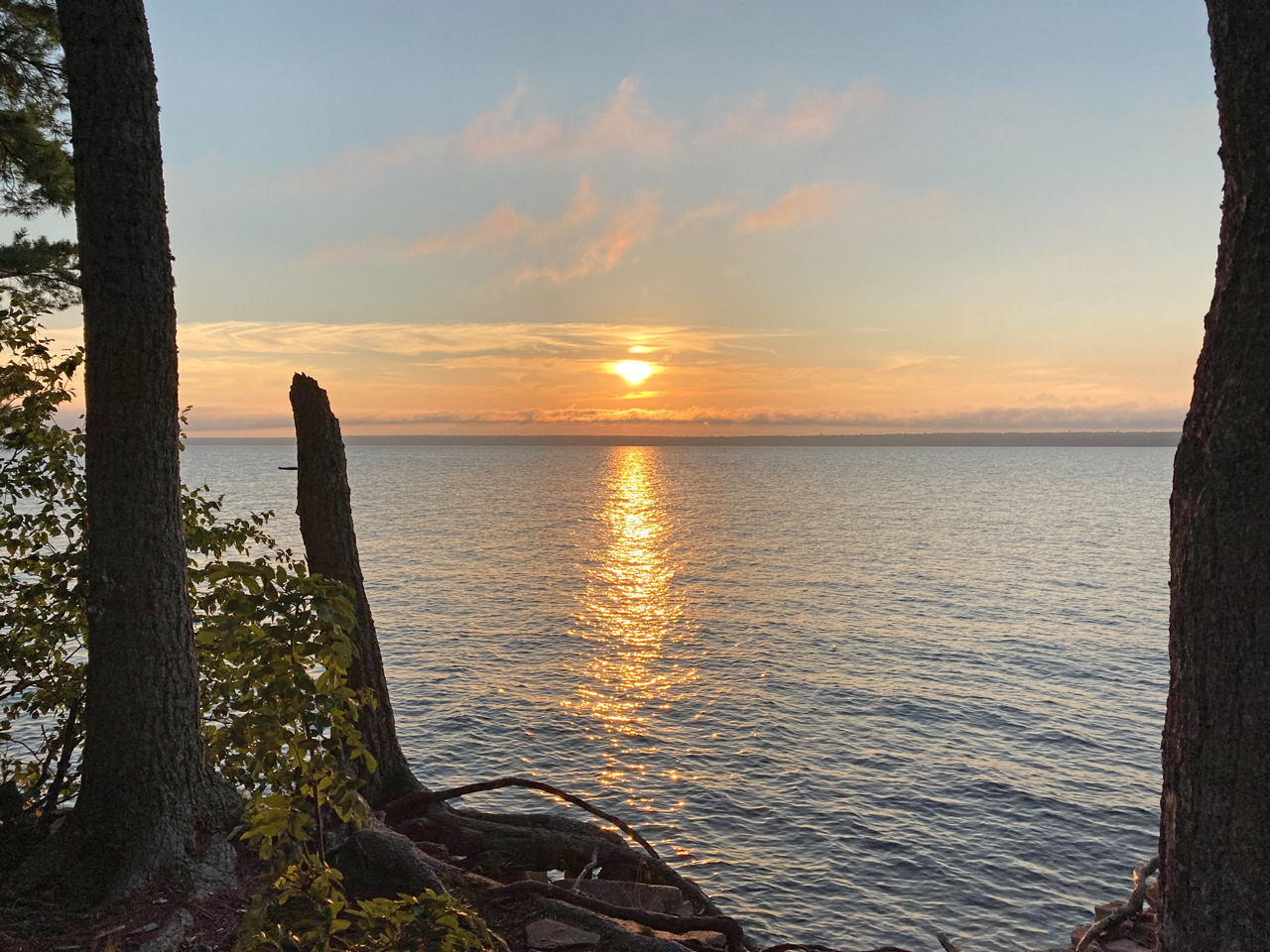
The 2021 Residency Selection Process
The 2021 open call received an unprecedented 902 applications. This was three times more than any previous open call, and represented a diverse set of proposals and practices.
The five member Selection Committee was composed of Rabbit Island alumni, a board member, and an independent museum professional. In response to a three-fold increase in the expected number of applications we extended the review period by an additional week to provide enough time for the Selection Committee to review every application. Additionally, we discovered about halfway through the application period that we would have an extraordinary number of submissions and invited the Committee members to begin reviewing applications from February 19th, as they were being received.
Three previous Rabbit Island Residents from the Committee read each submission’s text, reviewed work samples, and followed web links provided by applicants. They were then joined by the two additional Committee members who helped create an initial shortlist of exemplary applications.
The Selection Committee then met on March 27th and over the course of a seven-hour videoconference reviewed a shortlist of 103 applications, further narrowing it to a collective shortlist of 17 applications. The Committee then reviewed each of the 17 applications in detail once again. After several rounds of discussion, the Committee decided on a finalist list of 10 applications. The finalists were interviewed by videoconference for approximately 20 minutes each over the course of two days, 5 interviews a day, April 10th and 11th. The Committee deliberated for an additional 6 hours during the videoconferences over that weekend, ultimately reaching a decision to award 4 residencies.
View the Rabbit Island 2021 Residents here
Rabbit Island 2021 Residency Selection Committee
Alice Pedroletti, 2018 Resident
Duy Hoàng, 2018 Resident
Luce Choules, 2016 Resident
Patricia Buffa, Director of Digital Strategy for Fine Arts Museums of San Francisco
Rob Gorski, President of the Rabbit Island Foundation
Rabbit Island 2021 Residency Selection Coordinator
Andrew Ranville, Director of the Rabbit Island Foundation
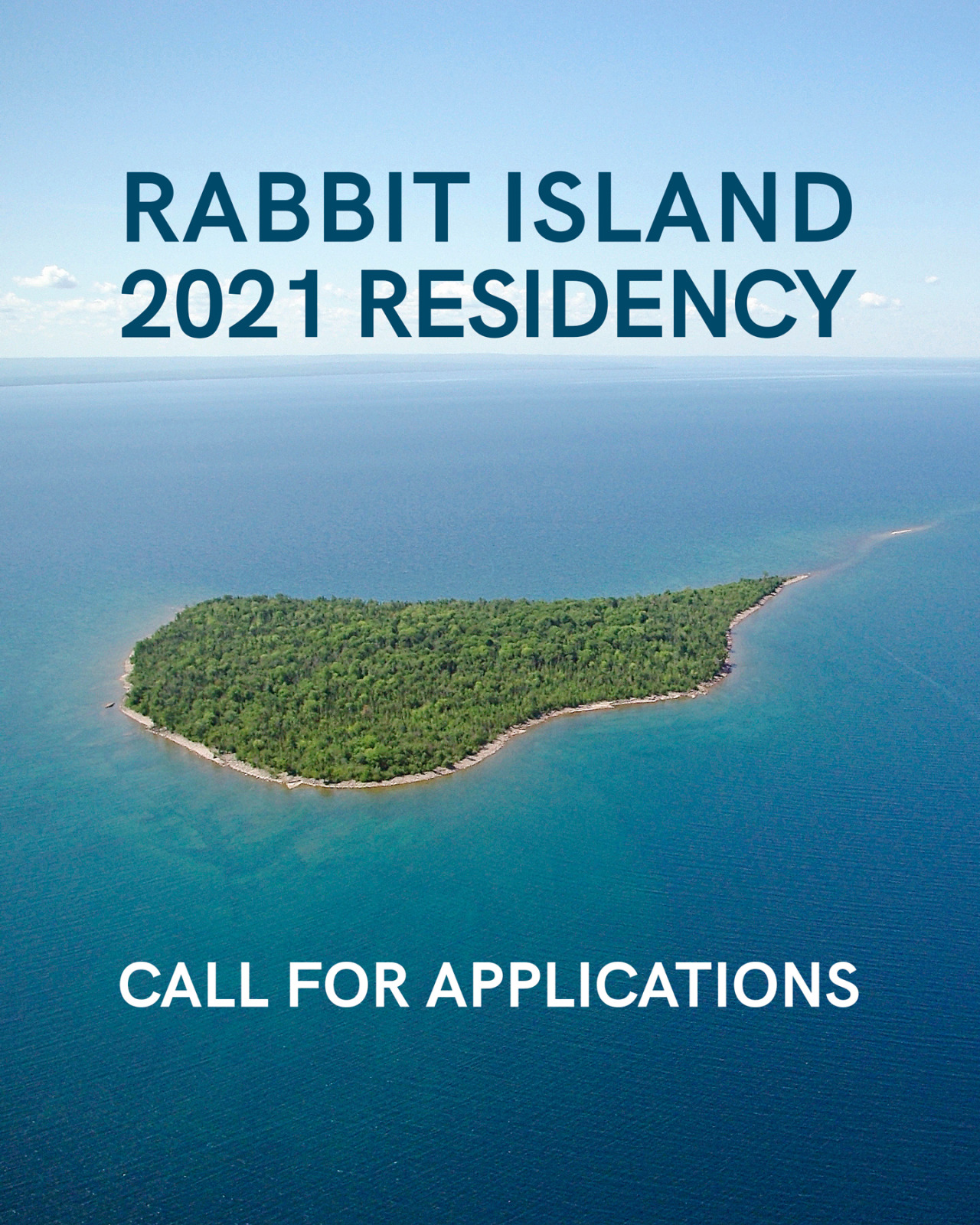
We are now accepting submissions for our 2021 Residency Program. Awarded residencies will receive an honoraria of $3,200 (USD) to live and make work amongst this remote island landscape located in the largest freshwater lake in the world. Visit the link below to download the Application Guide for complete award information, requirements, and submission instructions.
March 15, 2021 update — Our open call for applications is now closed, check back soon for information on the awarded residencies.
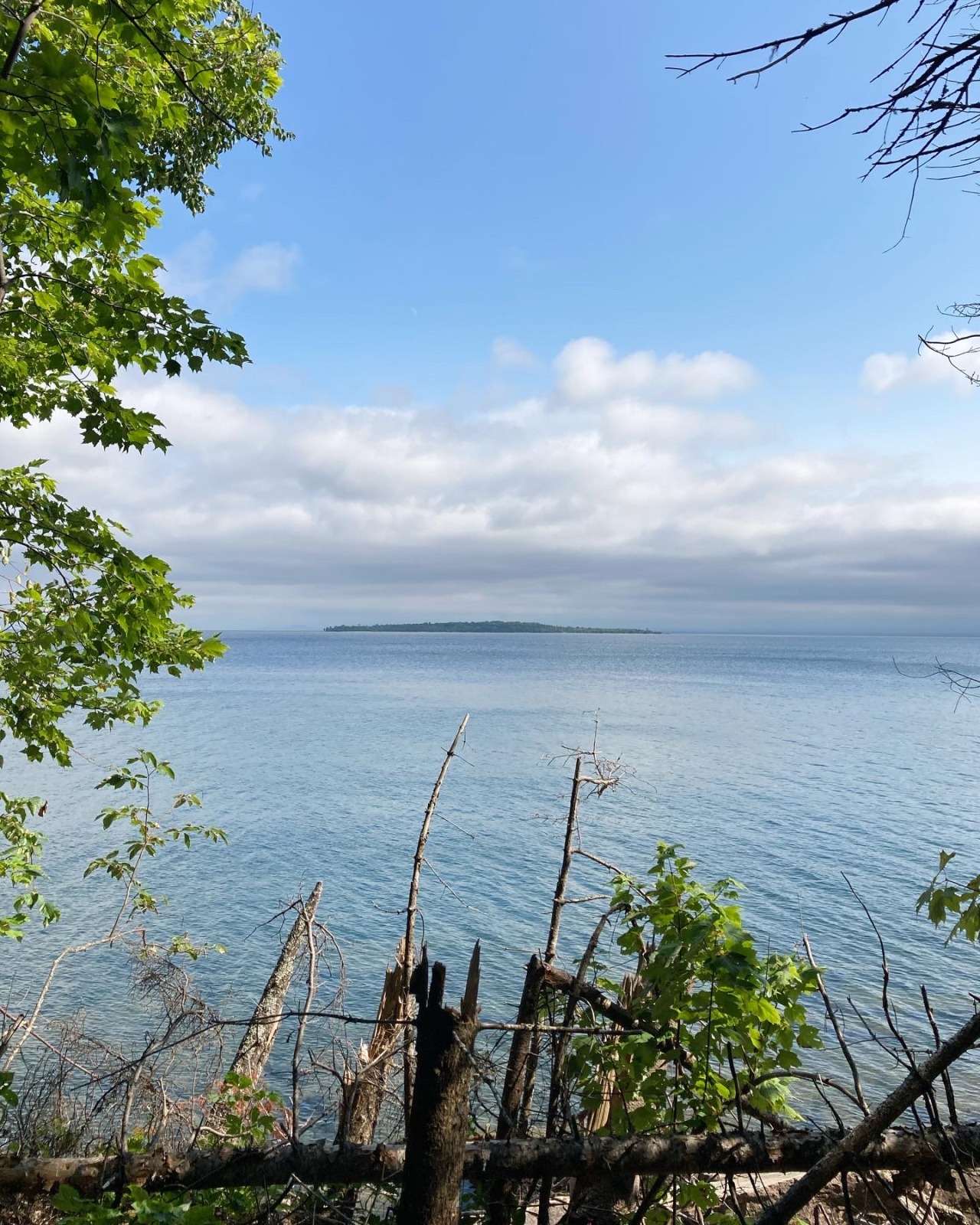
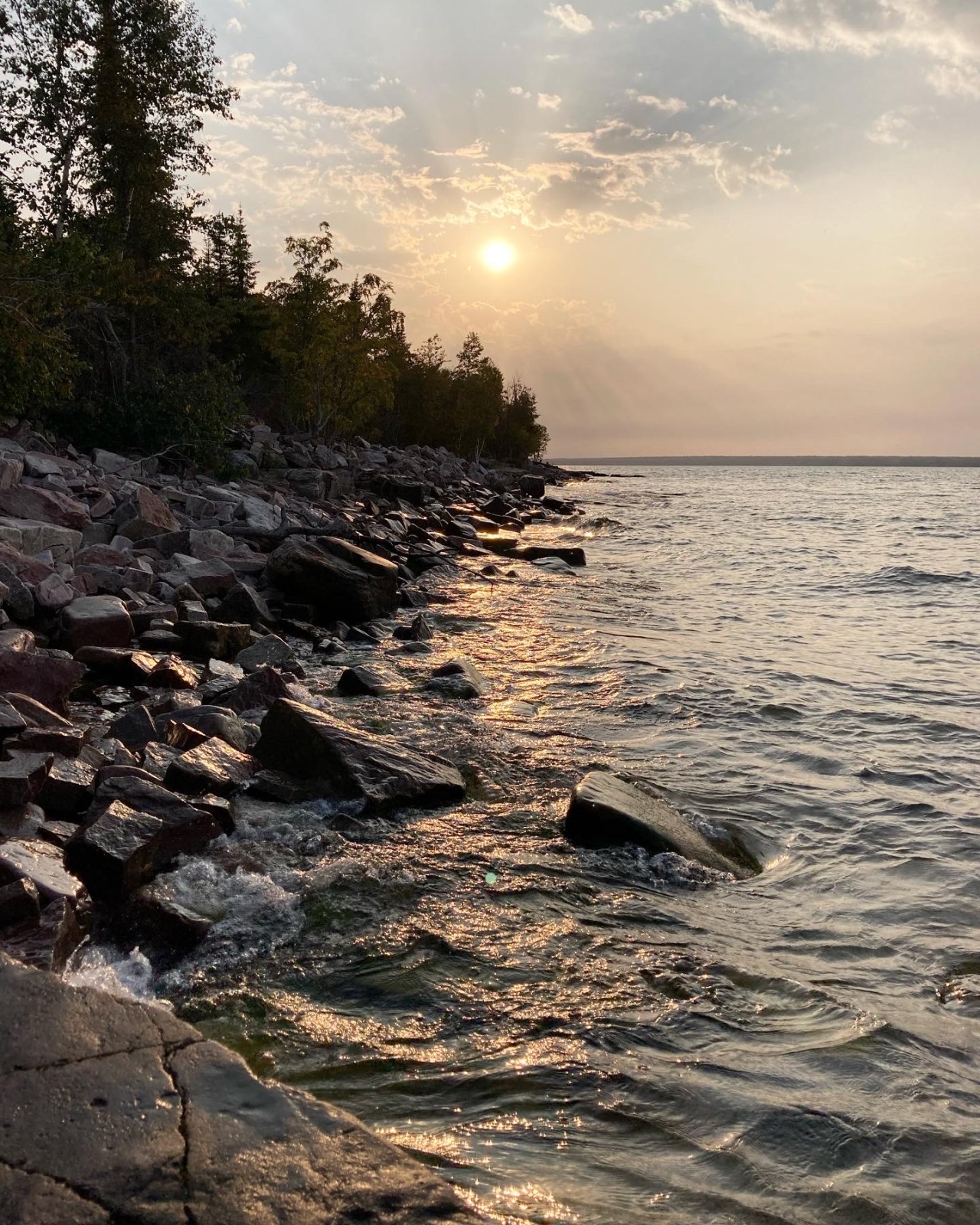
It has been a quiet year for Rabbit Island. This past summer season was intended to be a time of reflection with former residents and collaborators, looking back on a decade of activity. Together we hoped to learn where we have succeeded, and more importantly, where we can improve navigating this intersection of culture and conservation. Unfortunately, pandemic-related travel restrictions, financial constraints, and complications regarding gathering prevented the alumni program from taking place.
While only a handful of short visits were undertaken to check on the island infrastructure and to help ground the program’s philosophy with its place, a number of conversations and diligent work off the island were instrumental in preparing the program for the future. Critical needs that remain are providing opportunities for artists, and making clearer the path that weaves between art and ecology.
The Rabbit Island Residency is excited to announce its award of a CARES Act grant from the National Endowment for the Arts, which will help make the 2021 and 2022 residency seasons possible. While recognizing that unknowns lie ahead as pandemic-related restrictions continue to evolve, Rabbit Island intends to host residents through its supported programs. Details regarding the call for applications will be available online at the end of this year. Please join the mailing list to receive those announcements. Donations to help strengthen the program and grow the level of support awarded to residents can be made at our Support page.
Congratulations 2019 Residents
We are excited to announce awarded residencies for the 2019 Rabbit Island Residency program. We awarded three successful applications featuring a total of six artists. Each will live and work on Rabbit Island this summer.
Colin Lyons
Elias Sorich and Lucas Rossi
The Religion (represented by Lindley Elmore, Morgan Vessel, and Keegan Van Gorder)
Our 2019 open call received 253 applications representing individuals and groups from 25 countries.
A six member selection committee comprised of Rabbit Island alumni and administrators democratically chose the awarded residents. During February and March each committee member read application texts, reviewed each work submitted, and followed each web link provided. On many occasions members also independently researched previous works online.
Following this process the committee met via videoconference to discuss applications in detail and initially shortlisted 52 applications. After further discussion a refined list of 17 was selected. The committee then took two additional days to review those collectively shortlisted applications and chose 13 finalists who were interviewed for 25 minutes during videoconferences in late March. Finally, the committee members voted anonymously for their top three applications, resulting in the awarded residency positions. The Rabbit Island Foundation is extremely fortunate to have such a committed group of alumni who enrich and advance the residency program.
Below we are sharing the awarded proposals in full. We do so in the interest of transparency, archival intention, and to provide insight into the quality, critical nature, and ambition of the proposals we receive. We do so also fully understanding that the questions, research, and work put forward will likely change in time for each artist before, during, and after the residency. We look forward to working with the residents as their ideas evolve.
Since its inception in 2011 the Rabbit Island Residency program has awarded 26 supported residencies and hosted over 70 collaborators. Our open calls have received over 1300 applications highlighting artwork and ideas that critically engage issues of conservation and natural spaces. With the contemporary challenges society faces we are excited to have Rabbit Island’s residents contribute their research and work to this larger conversation.
The committee extends a sincere thank you to all the applicants. This year’s selection was extremely difficult given the large number of thoughtful proposals supported by exemplary work. While we regret not being able to offer more residency positions, it is an honor to be working with the following artists over the next year.
The 2019 Rabbit Island Residency Selection Committee
Julieta Aguinaco, 2017 Resident
Sarah Demoen, 2017 Resident
Jasmine Johnson, 2017 Resident
Calvin Rocchio, 2018 Resident
Rob Gorski, M.D., Cofounder
Andrew Ranville, Cofounder
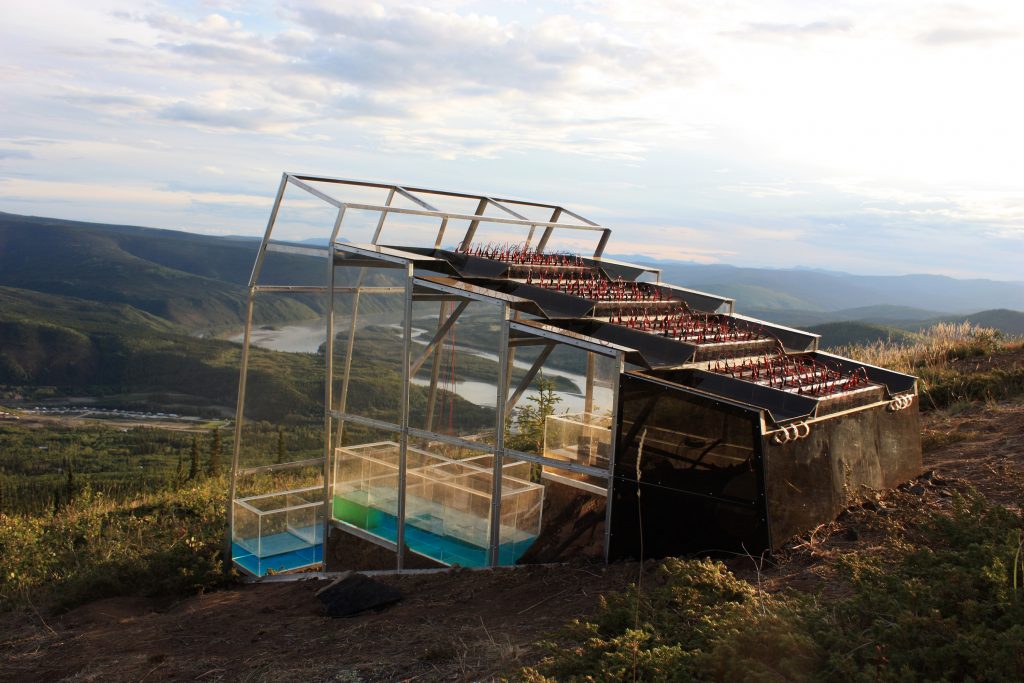
Colin Lyons
Biography
Colin Lyons was born in Windsor, Ontario in 1985, and grew up in Petrolia: ‘Canada’s original oil boomtown’. This experience has fueled his interests in industrial obsolescence and sacrificial landscapes. Lyons received his BFA from Mount Allison University (2007) and MFA in printmaking from University of Alberta (2012). He has presented 25 solo exhibitions and site-specific installations across Canada and the United States, as well as in group exhibitions internationally. His projects have been supported by the Canada Council for the Arts, Conseil des Arts et des Lettres du Québec, Alberta Foundation for the Arts, The Elizabeth Greenshields Foundation, and the National Endowment for the Arts. In 2016, he was awarded the Grant Wood Fellowship at The University of Iowa, and in 2013 he participated in the Kala Art Institute Fellowship in Berkeley. He currently lives in Binghamton, New York, where he is an assistant professor at Binghamton University (SUNY).
Artist Statement
My recent work considers preservation in an age of planned obsolescence and resource depletion. Deeply rooted in historical printmaking processes, these projects consider sacrificial landscapes through the lens of geo-engineering, urban renewal and brownfield rehabilitation. My experiments evoke an alchemical creation of time, memory and historical aura, as I propose new models for how we might memorialize and honor our collective history by re-integrating ritual and enactment into acts of remembrance.
Recently, I have begun developing a printmaking-based installation titled The Laboratory of Everlasting Solutions, in which I adopt the role of a practical alchemist, exploring the intersections between alchemical philosophies and contemporary climate-engineering technologies. The resulting laboratory will imagine fictitious and highly impractical prototypes, which allow brownfield remediation efforts to fuel monumental ideas about our collective future. The laboratory’s architecture may hover between a medieval alchemist’s laboratory, contemporary sustainable infrastructure, and ruin folly.
Proposal
I hope to work in the isolation of Rabbit Island to immerse myself in a 4-week hermetic durational performance, scribing an acid-based illuminated manuscript that will become a core part of The Laboratory of Everlasting Solutions. Throughout the Cold War, cloud seeding and weather modification programs gained broad bipartisan interest and concern, leading to several commissions on the technology. Throughout the residency, I will work to transcribe one of these congressional documents using a diluted solution of sulfuric acid as my pigment, punctuated with illuminated diagrams of Solar Radiation Management proposals. While the texts and images produced through this ritual performance will initially be invisible, they will reveal themselves over the next several decades as the acids discolor and eat away the paper, and the urgency around these technologies intensifies. The opportunity to produce this work within an isolated and unbuilt environment will help to inform the question of what exactly we strive to return to or approximate within a techno-solutionist future; a stark contrast with the sacrificial landscapes I typically work in. Throughout the residency, a daily ritual of exploring, collecting, and sampling will be followed by the hermetic and esoteric process of nightly transcription.
At its core, the science of geo-engineering attempts to mimic, accelerate, or amplify natural processes of carbon reduction using highly invasive means. These strategies form a dystopian contingency plan which, employed alongside mitigation efforts, strive to preserve a close approximation of our present ecosystem. However, instead of practical geoengineering prototypes, The Laboratory will present a future-oriented satire: time capsules which project a vision of the near future based on the realities and anxieties of the present. In their quest to transform base materials, alchemists sought transmutation towards a purer, more divine state. The notion that we might find salvation in the fine balance of strategic chemical spills defies belief in the same way the quest for a philosopher’s stone once did. However, within this critical debate, my role as an alchemist enables me to embrace impossibility, proposing prototypes which are symbolic, rather than practical, so that we may ponder this dilemma through a more philosophical lens.
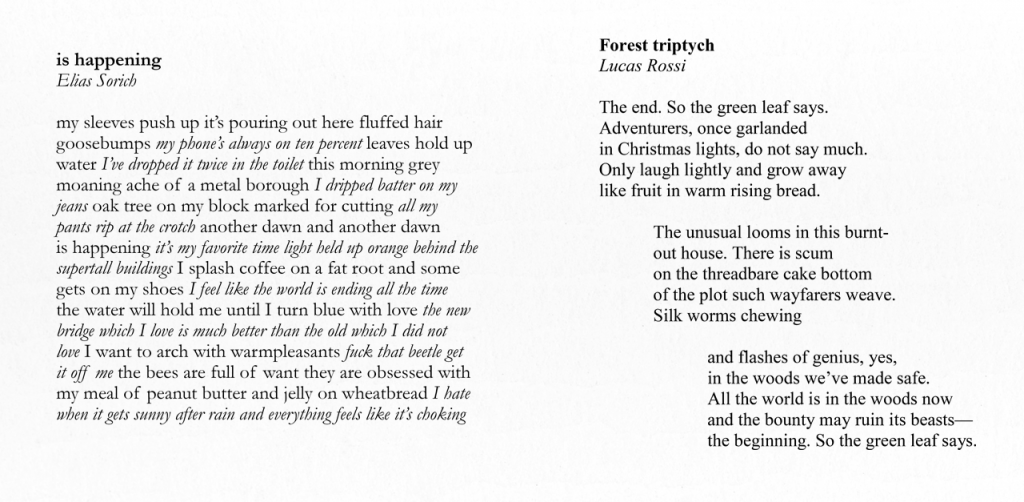
Elias Sorich and Lucas Rossi
Biography
Elias Sorich is a poet based in New York City, where he is pursuing a M.F.A. from Columbia University. He will be working as the Print Managing Editor of the Columbia Journal over the next years, and is currently a newsletter tinkerer in an administrative office, and a once-a-week writing teacher for a class of Armenian high school students. During the summer he will be traveling to Yerevan, Armenia to teach a workshop based on Folklore, Fairytale, and Myth. His work has been published in a handful of small but pleasant magazines.
Lucas Rossi is a writer living in Minneapolis, Minnesota. He will be pursuing an M.F.A in poetry at the University of Oregon beginning in the Fall of 2019. He works in a number of mediums in the arts, with projects involving poetry, prose, visual art, and music. He also really likes bugs.
Artist Statement
Elias’ work focuses largely on internal states of being, on the flux of emotions, and the instability of thoughts as they stew in the midst of living. I write to these questions with external gestures, I blend the borders between perceiving and being. The world inside is tied inexorably to the world of salamanders under rocks, toads overlooking the backyard stream. In this soup of internal-external figuring, I am a presence, a present figure–not a primary actor.
Lucas’ poetry involves both traditional formal aesthetics and a more contemporary green poetics, emanating from vegetarian upbringing as well as latent guilt in certain childhood experiences: failing to keep moths that I brought home from class alive, or carelessly flushing hundreds of ants out of our house’s concrete patio with a garden hose. Those microcosmic images, coupled with a larger awareness of impending climate catastrophes, define the focus of my work.
Proposal
Through a series of engagements with the bug life natural to the ecosystem of Rabbit Island, the two poets in this collaborative group will write towards the biomass that exists in, around, and beneath the ground they walk on.
From John Donne’s “The Flea,” to Heide Erdrich’s “Stung,” to Michael Dickman’s “Flies” there is something of a history in poetry of using insects to represent the human soul, its vices and virtues, and human thought processes, its pits and heights. Present in our work to date is a respect for, and embrace of, this relationship, and paramount to our aims for the Rabbit Island residency is the desire to embrace it further. We will explore new complexities of this literary relationship, particularly those brought on by the threat of global climate change, and the possibility of mass insect extinction. Through the opportunity to write in and around an environment at least mostly unadulterated, but that is in some larger sense threatened, we will explore how the subtle things in the natural world that make it function, impact the process of internal human undercurrents. What changes between the human and the nonhuman when the hyperobject of global warming casts a long shadow?
Our work during this residency will inspect the notion of the ecological catalogue. How do you make a living register? Account for the vitality of a species? What is lost when data does not retain the felt sense of inter-species contact? As two poets who write in harmony and conflict with one another, we will make a prismatic exploration of a freshly threatened population. Through our words, written on paper and expressed in other mediums, we will go after those elements of living left uncaptured in the environmental accounting of insect life. This will not be a simple chronicling of the insect population, but an attempt to create work that engages with these vital creatures in a more holistic sense. We will write towards them and away from them, a hum in the background, a bite on the skin, a leftover wing.
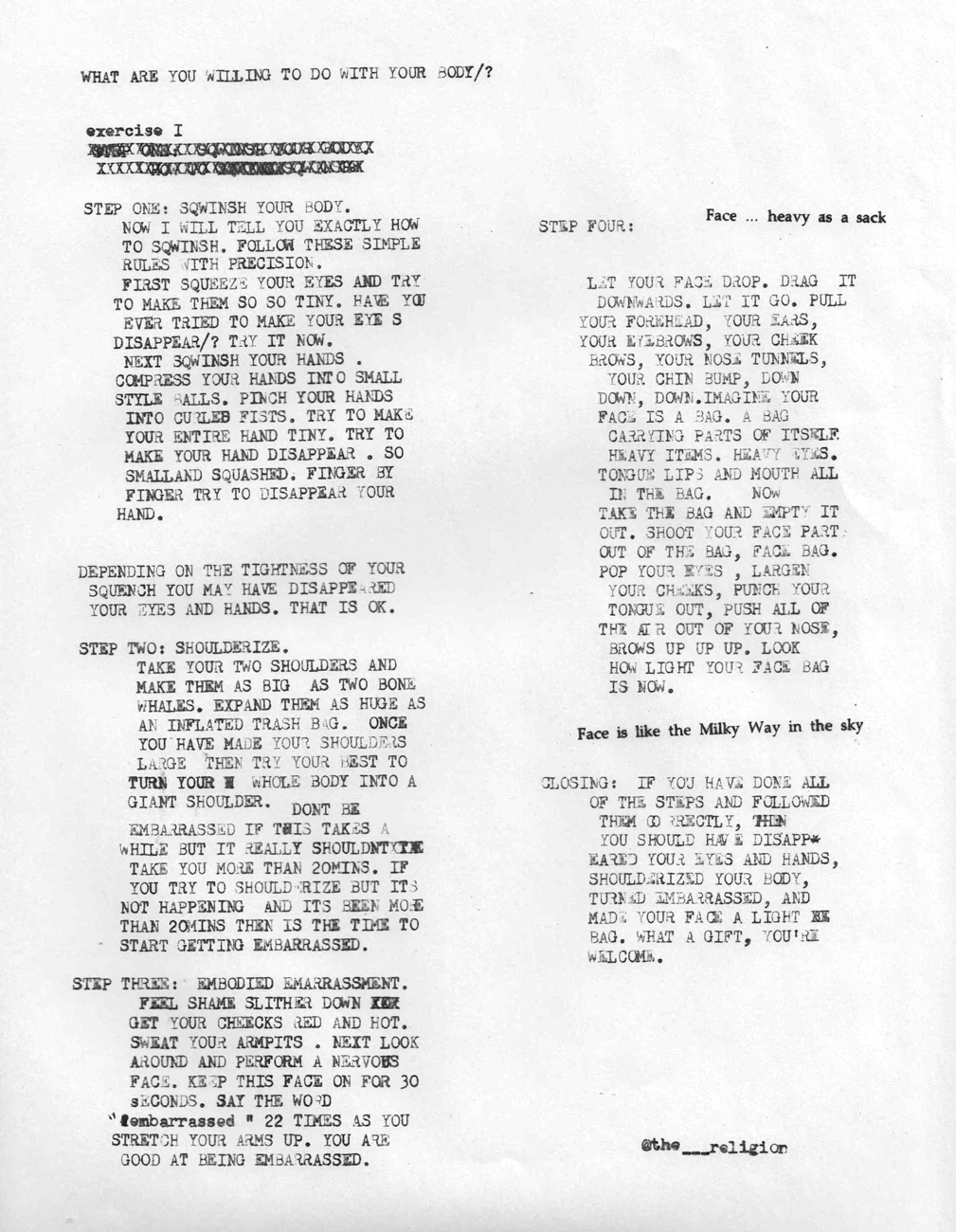
The Religion (represented by Lindley Elmore, Morgan Vessel, and Keegan Van Gorder)
Biography
The Authority Body of The Religion has appointed three trusted members of The Unclogged to practice and pass on our sacred teachings — Lindley Elmore, Morgan Vessel, and Keegan Van Gorder. The three have since shed their academic accolades and moved past their box topics (Sociology, Fine Art) and towards the One True Only Truth. Since their unclogging, their qualifications and markers of success are almost too vast to mention — practicing advanced ceremonies such as Nail Clipping Ceremonies, Grump Code, Fork Follow, Opera Plant Clipping, Exercises in Inefficiency, Housewarming Ceremonies, Selfishness Ceremony, Black Walnut Ceremony, Museum Walking Ceremony, and Making an Old Place New. While Lindley, Morgan, and Keegan live and operate in Minneapolis, The Religion continues to seek new members, collaborators, and dib-dabblers as they grow their body globally.
Artist Statement
The Religion is a project and community of people who are seeking to cultivate curiosity and goof through the creation of new events and experiences. The Religion is a set of beliefs that prioritizes Goofwork, making the profane sacred, materializing ideas and the use of Ceremony as a medium. Ceremony, the Religion’s core practice, helps us access the divine, asks us to try new ways of spending time, lets us re-examine our personal priorities, aims to stretch our stone-set comfort routines and encourages us (The Unclogged) to relearn how to value an experience for the sake of an experience. Ceremony is a tool that allows us to externalize questions, personal themes and new ideas through experiences that are deliberate, extensively planned step-by-step events or spontaneous, wild, improvisational idea-actions.
Proposal
The Religion’s practice asks us to consider our relationship to our socio-cultural environment and physical landscape. Our use of Ceremony encourages inquisitiveness and play through the investigation of place and our position within a larger regional space and social context. We’ve investigated community spaces through public events such as Silent Midnight Trash Bag Walk and Freedom of Information Booth at MSP-St. Paul International Airport. Our work seeks to disrupt the regular-ness of routines and everyday spaces (park / airport) through thoughtful, provocative new styles of re-engagement using movement, constructed legitimacy, ceremony and goof. Since the practice and creation of Ceremonies are heavily informed by our own context and physical environment, much of our ceremonies are centered around urban landscapes (Trash/Treasure Goose Chase, Landscape Investigations I and II, Museum Walking Ceremony), the modern workplace (Undercover Worse than Normal Employee), and happenings in our own lives (Heartbreak Parade, Tinder Ceremony, Ceremony for Fresh Eyes in an Old Place, Ceremony for Moving Out). Experience in past residencies – putting ourselves in new and different places has allowed us to engage new site-specific ideas and produce ceremonies from those locations (Cracking the Eggshell of Winter from our first winter residency in Minneapolis). We want to continue this focused collective investigation of local space in order to write new ceremonies, create community events and develop ideas that are inspired by and extracted from place. We wish to seek out spaces different from what we’ve been afforded in the past in order to engage, and export new topics and questions interpreted from that environment.
Through this residency we want to explore and produce new Ceremonies of differing scales. We wish to compose small ceremonies for our intimate collection of three, ceremonies for our mailed subscribers, and a final site-specific ceremony for the community near Rabbit Island. We wish to further investigate what influences and informs our work, especially the context of place. Our goal is to develop a relationship with Lake Superior, create a ceremony that is specific to our experience on Rabbit Island, and host the ceremony as an event for a small group of people.
